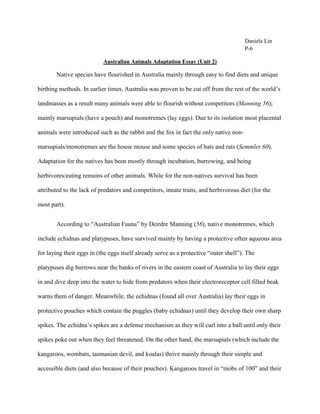
Unit2essay-Australian Animal Adaptation
- 1. Daniela Lin P-6 Australian Animals Adaptation Essay (Unit 2) Native species have flourished in Australia mainly through easy to find diets and unique birthing methods. In earlier times, Australia was proven to be cut off from the rest of the world’s landmasses as a result many animals were able to flourish without competitors (Manning 56); mainly marsupials (have a pouch) and monotremes (lay eggs). Due to its isolation most placental animals were introduced such as the rabbit and the fox in fact the only native non-marsupials/ monotremes are the house mouse and some species of bats and rats (Semmler 60). Adaptation for the natives has been mostly through incubation, burrowing, and being herbivores/eating remains of other animals. While for the non-natives survival has been attributed to the lack of predators and competitors, innate traits, and herbivorous diet (for the most part). According to “Australian Fauna” by Deirdre Manning (56), native monotremes, which include echidnas and platypuses, have survived mainly by having a protective often aqueous area for laying their eggs in (the eggs itself already serve as a protective “outer shell”). The platypuses dig burrows near the banks of rivers in the eastern coast of Australia to lay their eggs in and dive deep into the water to hide from predators when their electroreceptor cell filled beak warns them of danger. Meanwhile, the echidnas (found all over Australia) lay their eggs in protective pouches which contain the puggles (baby echidnas) until they develop their own sharp spikes. The echidna’s spikes are a defense mechanism as they will curl into a ball until only their spikes poke out when they feel threatened. On the other hand, the marsupials (which include the kangaroos, wombats, tasmanian devil, and koalas) thrive mainly through their simple and accessible diets (and also because of their pouches). Kangaroos travel in “mobs of 100” and their
- 2. diet is relatively casual consisting of grasses, leaves, other plants, and water; their pouches nurse their young (contain teats) and hide them from danger. Wombats eat mainly roots, bark, moss, grass, and other plants which are easily found in all of Australia (“An Island full of vegetation”) they also have reverse pouches that prevent dirt and other foreign objects from entering it when it burrows. Tasmanian devils are scavengers that feed on the remains of other animals or sometimes eat small mammals. As a result, of feeding off leftovers, being nocturnal, and intimidating with its powerful jaws and sharp teeth the tasmanian devil has relatively no predator and thus has been able to thrive. Koalas have “grooming claws” and rough pads to help them climb the forests of Australia; their diet consists of eucalyptus leaves found in mainland Australia and water from dew and rain that collects on the leaves. In the short text of “New to Australia” by Aidan Semmler (60), it’s stated that although Australia has many of the rarest animals in the world most that aren’t marsupials/monotremes are introduced species. These non-native species have thrived overtime by getting rid of competition (the natives) with their adaptability. From the rabbits that were brought by Austin in 1859 to the foxes in the mid-1800s, they have all started growing in numbers and thus wiping out native species of plants and animals. Millions of feral camels, cats, goats, and pigs have few predators which accounts for their success (their huge numbers have resulted in a devastating death toll of the natives). The most dangerous of them all is the cane toad which was brought over from Hawaii in 1935 to thwart the expansion of the native cane beetle (a devastator of sugarcane). Overtime though the cane toad have killed natives like the quoll with their poisonous exterior. Through relatively simple diets, innate characteristics, adaptability, and their advantageous surroundings foreign and native species alike have been able to flourish on the Australian continent for at least a thousand years now. Australia’s deciduous forests, rainforests,
- 3. and riverbanks provide easy cover and resources for many such as the platypus, emu, koala, wombats, and etc. Although some successes have been compromised with disaster for Australian natives their adaptability rate is still impressive (Semmler 61). Not all non-natives bring chaos along there are ones like the dingo (relative of the domesticated dog brought from Asia) that hunt the excessive population of rabbits which might better the lives of the natives. Regardless of the species’ origin they all have adapted through natural selection successfully in Australia.
